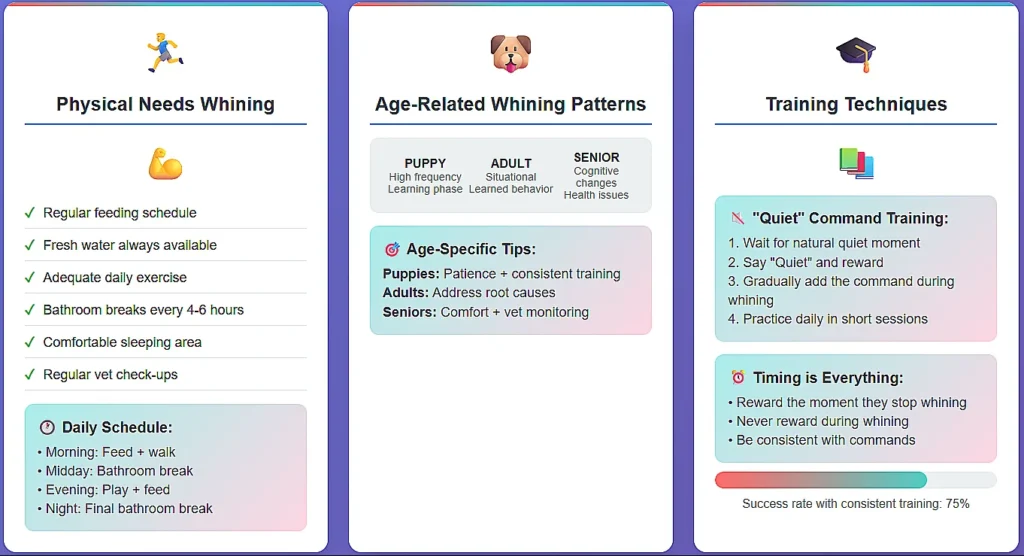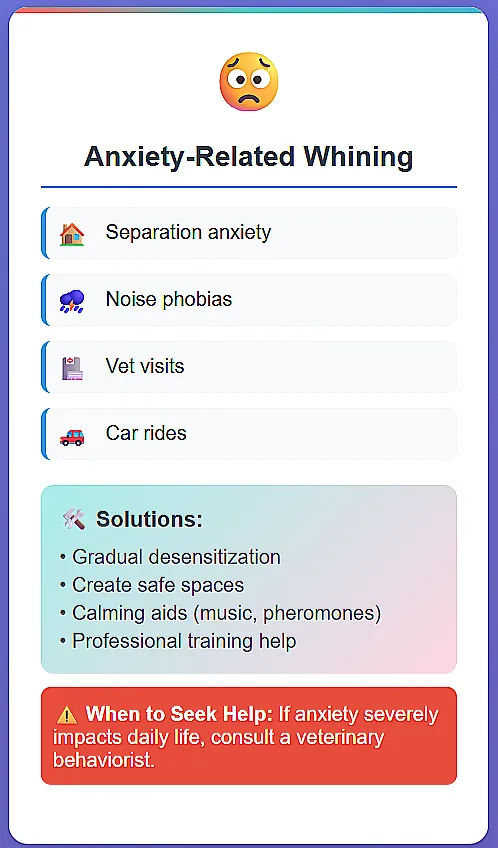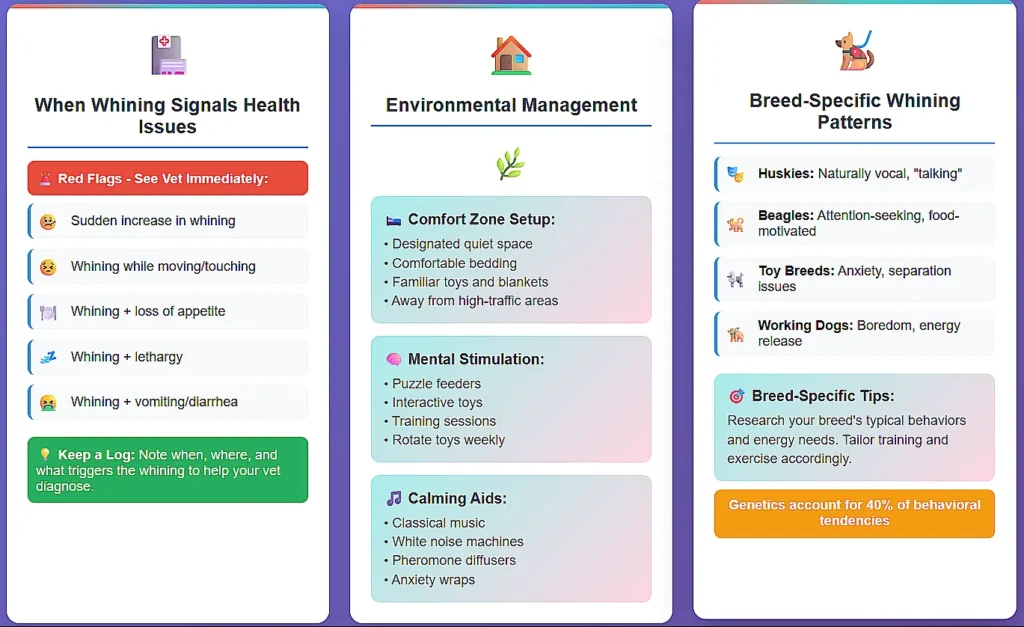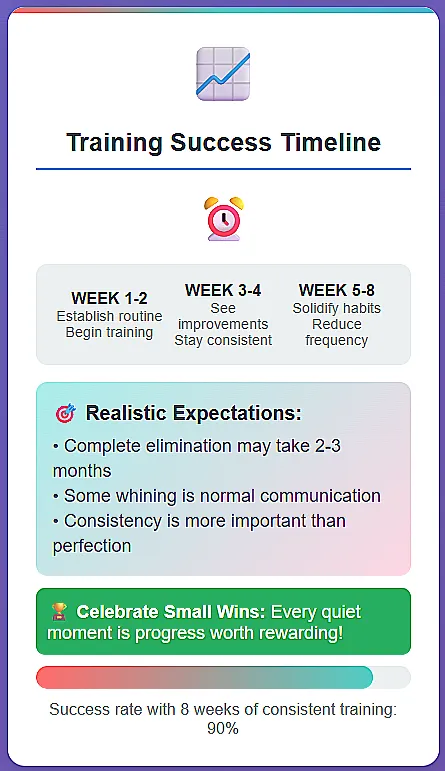
Ever wonder, “Dog whining reasons—why is my dog always whining?” You’re not alone. Whether it’s a late-night whimper, constant crate fuss, or puppy whining constantly without clear cause, it gets old fast.
It’s not just annoying—it can be a sign your furry friend is struggling. You’re here because you need answers and—more importantly—solutions. You want peace in your home, a calmer pup, and real connection with your best buddy.
You’re about to discover:
- The true roots behind dog whining behavior
- How to tell apart normal vs. problematic whining
- Expert-backed tips, vet insight, and life-tested fixes
- FAQs covering dog whining at night, dog separation anxiety signs, older dog whining, and more
Say goodbye to guessing games and hello to a calmer, happier pup—let’s dig in!
Understanding Dog Whining Behavior: What Is It Telling You?
Whining isn’t just noise—it’s canine communication. Much like us, dogs Whines signal emotions, needs, or discomfort.
Whining vs barking: different sounds, different meanings
You might wonder, “Is my dog whining for attention or because something’s wrong?” Experts note whining is usually higher-pitched and emotionally loaded, often paired with body signals like ears back or tail tucked. Barking, on the other hand, is more situational or alert-driven.
Dog cries for no reason? It’s usually a reason
Sometimes it seems like your dog is whining with no cause—but look closer. They might be in pain, bored, craving attention, anxious, or trying to appease you thesprucepets.com. That “no reason” whining often has a deeper story.
Top 8 Dog Whining Reasons (And How to Address Them)
Here’s a deep dive into the most common dog whining reasons, with actionable insights and quick fixes.

Seeking Attention / Dog whining for attention

Your dog learns whining gets results—sometimes too well. If pausing an activity or serving a treat follows the whine, you’re reinforcing it basepaws.com.
Fix it:
- Set calm boundaries: wait for quiet, then engage.
- Offer toys or chewing posts when you’re busy.
- Reward silence with praise or treat—“quiet = good stuff.”
Wants Something: Food, Walk, or Toy
Ever fed your pup already, and they whine again at 7 pm? They might be manipulating for extra treats or because of a bladder issue.
Solution:
- Stick to fixed feeding and walking schedules.
- Ignore the whining; respond only when quiet.
- For night-time calls, keep calm lighting and low interaction.
3. Anxiety & Dog separation anxiety signs
Whining paired with pacing, panting, or crate distress might be separation anxiety, that midnight whimper? It’s emotional distress, not defiance.

What to do:
- Build up time away slowly—vanish for 30 seconds, then return.
- Use puzzle feeders, snuffle mats, or Kong toys.
- Consider calming collars or pheromone diffusers.
- Training and vet support (e.g., behaviorist) can help.
4. Boredom: Dog boredom symptoms that speak volumes
A bored dog can whine, pace, chew floors—you name it zoetispetcare.com.
Fixers:
- Add walks, playtime, sniffing outings (“sniffari”).
- Mental enrichment: puzzle treats, training, new toys.
- Rotate toys weekly to spark interest.
5. Pain signals: Dog pain symptoms you can’t miss
Whines during standing, sitting, or climbing can signal pain—arthritis, an injury, digestive upset
Act fast:
- Observe body language—limping? flinching?
- Visit the vet for a check-up and pain management.
- Monitor recovery closely after any injury.
6. Excitement: High-arousal whines
Dogs often whine in anticipation—like every time you grab a leash. It’s not anxiety—it’s buzzed out of excitement!
Calm it down:
- Greet gently, not like you’re meeting a rock star.
- Teach calm greeting cues (sit-and-wait).
- Reward subdued behavior, not the over-the-top welcome.
7. Appeasement behavior: Dog distress signals
A tense whine with a tucked tail or avoidance posture? That’s submission or fear—your dog telling you “I don’t want trouble”
Boost confidence:
- Avoid punishment.
- Use reward-based training (trick classes, agility).
- Build social exposure in low-stress ways.
8. Appeasing Whine: Saying “Sorry” after scolding
Yeap, dogs say sorry—if they whine after being scolded and then drop to submissive posture, it’s a canine apology—a pack peace offering aspca.org.
How to help:
- Accept the apology; move on.
- Keep routines consistent—no mixed signals.

Real-Life Stories: Whining unmasked
“Midnight Cries” with Joy, the Golden Retriever
Joy whined every night in his crate—until vet advice led to a slow night-time routine: calming music, a snuffle mat with hidden treats, and evening walks. Within a week, bedroom peace—and no whines.
“Lazy Whiner” Sadie, the Chihuahua
Sadie whined nonstop when her owner watched TV. Turns out she’d never been taught quiet behavior. A training plan—with calm, brief walks and chew toys—trained her: silence equals attention.
How to Stop Dog Whining: Training Strategies That Work
Here’s a quick guide for dealing with whining depending on why it happens.
- Pinpoint the trigger: pain, attention, anxiety, boredom?
- Meet basic needs: food, water, walk, comfort.
- Ignore non-urgent whining until silence.
- Reward quiet moods with a treat or affection.
- Add stimulation to prevent boredom.
- Seek vet help if pain or severe anxiety seems likely.

Common Questions About Dog whining reasons
What if my puppy is whining in sleep?
Puppies often whine during dreams—no need to intervene unless pain signs appear.
Why is my older dog whining?
Aging brings joint pain, cognitive decline, or sensory losses. Vet visits and comfy beds help.
My dog whines in crate—what to do?
It can be separation anxiety or lack of crate training. Use gradual crate exposure and treat-filled toys.
Why dog whining after eating?
May signal indigestion or discomfort. Observe closely and consult vet if consistent.
Dog whines with toy—what gives?
They might be excited, frustrated, or reminding you playtime’s on their terms. Teach gentle “drop it” cue calmly.
Conclusion
Whining is your dog talking—you just need to listen. Whether boredom, pain, or pure joy, understanding dog whining reasons is step one. Let’s recap:
- It’s communication, not always bad
- Look at body language and context
- Use positive training, stimulation, and vet care
- Be consistent—you’ll see progress in weeks
You’ve got this—and your pup is worth it. Try one new fix tonight. Did it work? Share your story in the comments, and don’t forget to pin this for future reference!










